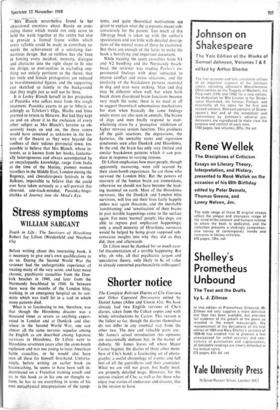Death in Life : The Survivors of Hiroshima
Stress symptoms
WILLIAM SARGANT
Robert Jay Lifton (Weidenfeld and Nicolson 65s)
Before writing about this interesting book, it is necessary to give one's own qualifications to do so. During the Second World War the reviewer had the unforgettable experience of treating many of the very acute, and later more chronic, psychiatric casualties from the Dun- kirk beaches in 1940, and later from the Normandy beachhead in 1944. In between there were the months of the London blitz, working in an emergency hospital on its out- skirts which was itself hit in a raid in which many patients died.
What is so fascinating to me, therefore, was that though the Hiroshima disaster was a thousand times as severe as anything experi- enced in London and at Dunkirk and else- where in the Second World War, one saw almost all the same nervous sequelae among the English as are described among Japanese survivors in Hiroshima. Dr Lifton went to Hiroshima seventeen years after the atom-bomb explosion and was too young to treat American battle casualties, or he would also have seen all these for himself first-hand. Unfortu- nately, before writing an earlier book on brainwashing, he seems to have been well in- doctrinated on a Freudian training couch and so, in this book as in his one on thought re- form, he has to see everything in terms of his own metaphysical interpretations of the symp- toms, and quite theoretical motivations are given to explain what the symptoms meant sub- consciously for the patient. Too much of this 500-page book is taken up with the author's speculations and too little with detailed descrip- tions of the mental states of those he examined. But there are enough of the latter to make the book a horrifying and important document.
While treating the acute casualties from VI and V2 bombing and the Normandy beach- head, the reviewer was reading Pavlov's ex- perimental findings with dogs subjected to intense conflict and stress situations, and the similarity of the breakdown pictures recorded in dog and man were striking. Man and dog may be different when well, but when both break down disordered brain functions become very much the same; there is no need at all to suggest theoretical subconscious mechanisms for man when basically the same findings under stress are also seen in animals. The brains of dogs and men finally respond to over- whelming stress by a 'protective' inhibition of higher nervous system function. This produces all the guilt reactions, the depressions, the hysterias, the unreality states and regression syndromes seen after Dunkirk and Hiroshima. In the end, the brain has only very limited and similar breakdown patterns which it can pro- duce in response to varying stresses.
Dr Lifton emphasises how most people, though apparently recovering, were still scarred by their atom-bomb experiences. So are those who survived the London blitz. But the powers of recovery of the human brain are tremendous, otherwise we should not have become the lead- ing mammal on earth. Most of the Hiroshima survivors, like the Dunkirk and London blitz survivors, will live out their lives fairly happily unless war again threatens, and the inevitable 'conditioning' and 'sensitisation' of their brains to past terrible happenings come to the surface again. For most 'normal' people, like dogs, are able to repress past unpleasant happenings; only a small minority of Hiroshima survivors would be helped by being given supposed sub- conscious insights into why they did as they did, then and afterwards.
Dr Lifton must be thanked for so much care- ful documentation of a terrible happening. But why, oh why, all that psychiatric jargon and speculative theory, only likely to be of value to already converted psychoanalytic colleagues?






































 Previous page
Previous page